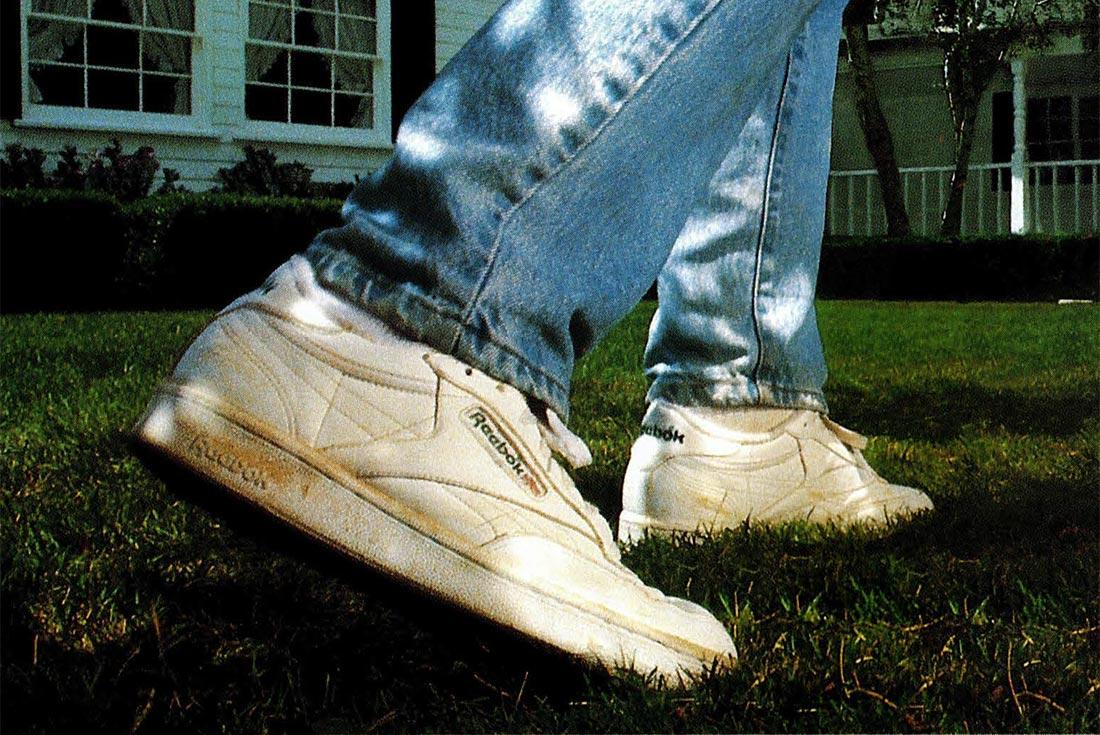Creating a Classic: How Reebok Championed the Club C
The is a time capsule of 1980s tennis style. An archetype of the crisp white leather sneakers born during the sport’s classiest era, the ‘Club Champion’ has more than lived up to its name over the years. In the blink of an eye the model just turned 35, yet still doesn’t look a day older than when it arrived in 1985. If it ain’t broke, don’t fix it!
Today, the Club C headlines the Reebok Classics roster, though it has picked up some contemporary collaborative clout in recent times. Like its straightforward tennis silhouette, the understated story of the Club C is all part of its timeless charm.
Creating a Classic
At first glance, the Club C appears to be a simple combination of leather, nylon and rubber. But beneath the surface, well, to be honest, that’s pretty much all there is! However, that’s not just any old cow the Club C is made from – it’s Reebok’s game-changing garment leather. A light and supple alternative to the heavy hides of old, the use of garment leather signified luxurious comfort right out of the box.
Strategic perforations across the Club C’s flanks prevented overheating and worked in tandem with the ventilated nylon tongue. The terry cloth lining is still supremely breathable, wicking sweat away from moist feet. What may look like a regulation cupsole is actually what’s known in the design biz as a 3/4 wrap sole, because it stops short at the medial arch. A pocket of EVA foam peeks through, revealing the spongy cushioning at the Club C’s core.
As we said in the intro, the Club C is a straightforward and effective design. But it wasn’t conceived overnight. In fact, the Club C has gone through several variations since it debuted in 1985. And it likely wouldn’t exist today if not for the footwear fundamentals pioneered by Reebok in the early 1980s.
Life is Not a Spectator Sport
The early-80s was a sensational time at Reebok. In 1982, the brand conquered America thanks to the femme-focused , which rode the aerobics fitness wave all the way to the bank, turning Reebok into a performance powerhouse overnight.
The Freestyle provided Reebok with a blueprint for the , and models that followed soon after. Reebok’s pastel-toned full-page adverts turned generations of fitness-first consumers into white leather crep connoisseurs with the rousing ‘Because Life is Not a Spectator Sport’ slogan.
While the fitness craze was booming across America, tennis was entering a golden era and Reebok wanted a piece of the grass court action. Their first serve in 1984 turned out to be an ace with the – a shoe that lived up to its bold promise of needing no ‘break-in’ time.
Club Champion
The following year, Reebok received over 10,000 orders for their Revenge tennis shoe, which at the time was known as the Revenge Plus in the United Kingdom. At the same time, the US was allocated distant relatives in the form of the Club Champion (aka the Club C) and Club Classic (aka the Love in the UK market), which were designed for men and women respectively.
By 1989, the Club C’s predecessors were gradually phased out. In the years that followed, female sizing was added to form a Club C franchise, along with variations like the Club C Wide and Club C Canvas, both of which popped in and out of seasonal collections. In 1993, Reebok defined their icons with the foundation of Reebok Classics, of which the Club C was an original member.
Colab Kings
While OG Club C retros and period-correct variants have been staples of the Reebok Classics line for over 30 years, the basic baseline specialist was spectacularly reimagined a few years ago as a go-to collaborative model.
The late-2010s was a prolific time with everyone from supermodels, streetwear labels and cartoons reworking the Club C. The past couple of seasons alone have netted some of the Club C’s finest moments. The edition was undoubtedly one of 2019’s cleanest colabs, while the two-toned edition in suede was a tactile dream. Over in Japan, glued the midfoot strap to the top of Club C for an all-new hybrid.
Some altogether unexpected moments arrived courtesy of the cosmetics company FACE Stockholm, which served up a Club C complete with a selection of make-up samples. The super cute Tom and Jerry collection also strengthened the Club C’s all-ages appeal.
On the skate front, long-time Reebok partners highlighted the humble tennis-turned-skate sneaker with multiple griptape-ready releases. Skate compatriots also managed to reference an infamous ‘G-UNIT’ Bok from back in the day! In more recent times, SNEEZE Magazine applied their signature bubble-font logo to the crisp white exterior of the Club C.
Forever Young
2020 marks the 35th anniversary of the Club C, but the milestone hasn’t been marked with raucous fanfare or over-the-top celebrations. Reebok have simply respected the model’s status as a certified classic, which seems totally appropriate for the ultimate quiet achiever. Perhaps it’s another case of less is more. Reebok certainly believe so – both the white-on-white and the white/navy Club C editions are still the top sellers to this day. Game, set, match!
